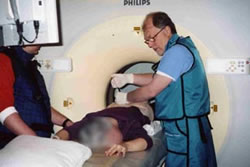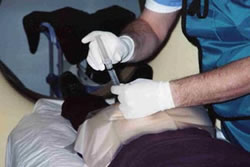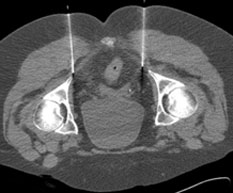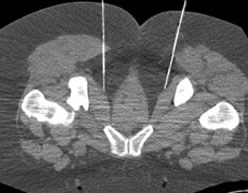The pudendal nerve provides the majority sensations and functions of the external genitals, the urethra, the anus, and perineum. It also controls the external anal sphincter and the sphincter muscles of the bladder. Image-guided pudendal nerve block is the most important diagnostic test following history and physical examination for patients with suspected pudendal neuralgia. The nerve is blocked by a local anesthetic to see if symptoms can be eliminated by numbing the nerve. The block is done where the nerve is passing between the two ligaments or in the Alcock's canal.




Frequently Asked Questions
- What is Pudendal Nerve Entrapment?
- Pudendal nerve entrapment is a pain condition for no apparent reason in the lower central pelvic areas. These are the anal region, perineum, scrotum and penis or vulva. Pain is worse upon sitting and less when standing or sitting on a donut cushion or toilet seat. The pain could be stinging, burning, stabbing, aching, knife-like, irritation, cramping, spasm, tightness, crawling on the skin, twisting, pins and needles, numbness, and hypersensitivity. The pain is piercing and very comparable to a toothache. It often starts in one place and progresses. Frequently there is also urinary, anal, or sexual dysfunction. The pain is often on both sides.
- What causes pudendal nerve entrapment?
- Pudendal nerve entrapment is caused by entrapment of the pudendal nerve. The initial constriction is often caused by pressure or trauma. As the nerve swells it encounters a natural constraint. Stretching or rubbing of the pudendal nerve can also cause pudendal nerve entrapment.
- What causes entrapment?
- Pudendal nerve entrapment is usually precipitated by prolonged sitting or trauma to the sitting area, combined with a genetic and developmental susceptibility. Pudendal nerve entrapment is common in high mileage and it is sometimes called Cyclist's Syndrome.
- What is pudendal nerve entrapment frequently misdiagnosed as?
- Prostatodynia, nonbacterial prostatitis, idiopathic vulvodynia (idiopathic means unknown cause), idiopathic orchialgia, idiopathic proctalgia, idiopathic penile pain syndrome etc.
- What are the most common symptoms of PNE?
- The main symptom is pain with sitting. You feel great in the AM until you sit for coffee, or drive to work. You get better with lying down. The pain is in the distribution of the pudendal nerve....genitalia, perineal or rectal. It can be any combination of these areas depending on the part of the nerve entrapped.
- What are the treatment options?
-
- Avoiding the offending factor that causes pain
- Three sequential image-guided nerve blocks, first with local anesthetics and later possibly combined with corticosteroids
- Conservative medical treatment such as neurotin, Elavil
- Surgery with decompression of the nerves is rarely done
- If a patient suspects that they have pudendal what should they do to get help?
- First, you need to make sure that other possible conditions are ruled out. It is important to have a complete workup. Next is an image-guided nerve block and if you get numb in the area of your pain and pain is gone you have a good indication that you might have pudendal neuralgia.
- Is there a connection between pudendal neuralgia and spinal disorders and scoliosis?
- No